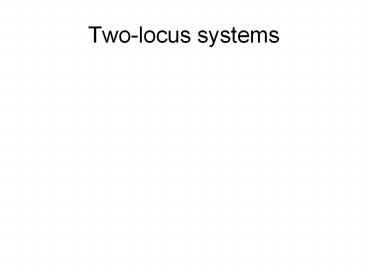Two-locus systems - PowerPoint PPT Presentation
Title:
Two-locus systems
Description:
Two-locus systems Scheme of genotypes Two-locus two allele population Table gametes from genotypes I Table gametes from genotypes II Table zygote productions Two ... – PowerPoint PPT presentation
Number of Views:60
Avg rating:3.0/5.0
Title: Two-locus systems
1
Two-locus systems
2
Scheme of genotypes
Two-locus genotypes
genotype
genotype
genotype
Multilocus genotypes
3
Two-locus two allele population
Gamete
p1 p2 p3 p4
Next generation on zygote level
Independent combination of randomly chosen
parental gametes
4
Table gametes from genotypes I
(1-r) no cross-over
(r) cross-over
Type zygote- one locus is homozygotes
Zygote
Zygote (AB,Ab) have gamete (AB) with frequency
0.5(1-r)0.5r0.5
gamete
0.5(1-r)
0.5(1-r)
0.5(r)
0.5(r)
5
Table gametes from genotypes II
(r) cross-over
(1-r) no cross-over
Type zygote- both loci is heterozygotes
Zygote
Zygote (AB,ab) have gamete (AB) with frequency
0.5(1-r)
gamete
0.5(1-r)
0.5(1-r)
0.5(r)
0.5(r)
6
gamete
Position effect
7
Table zygote productions
AB p1p12p1p2p1p3(1-r)p1p4rp2p3
Evolutionary equation for genotype AB
8
p1p12p1p2p1p3(1-r)p1p4rp2p3 p2p22p1p2p2p
4rp1p4(1-r)p2p3 p3p32p3p4p1p3rp1p4(1-r)p2p
3 p4p42p3p4p2p4(1-r)p1p4rp2p3
r is probabilities of cross-over (coefficient of
recombination). Usually 0? r ? 0.5. If r0.5 then
loci are called unlinked (or independent). If r0
then population transform to one loci population
with four alleles.
AB Ab aB ab p1 p2 p3 p4
9
Measure of disequilibria D p1p4-p2p3
10
p1p1- rD p2p2 rD p3p3 rD
p4p4 - rD.
p1p2p(A) p1p3p(B)
AB Ab aB ab p1 p2 p3 p4
Gene Conservation Low p1 p2 p1 p2p(A)
p1 p3 p1 p3p(B)
11
Two-locus two allele population. Equilibria.
p1p1- rD p2p2 rD p3p3 rD p4p4 - rD.
Measure of disequilibria D p1p4-p2p3
D0 p1p4 p2p3
12
p1 p(A) p(B) p2 p(A) p(b) p3 p(a) p(B) p4
p(a) p(b).
In equilibria point the genes are statistically
independence.
But the genes are dependent physically, because
are in pairs on chromosome
Measure of disequilibria D p1p4-p2p3
13
Convergence to equilibrium
p1p1- rD p2p2 rD p3p3 rD p4p4 - rD.
Dp1p4- p2p3
D(p1- rD )(p4 - rD)-(p2 rD)(p3 rD)
p1 p4- p2p3
-rD(p1p2p3p4)
(rD)2-(rD)2
D
D(n)(1-r)nD(0)
DD-rD(1-r)D
Maximal speed convergence to equilibrium for r0.5
D(n)(0.5)nD(0)
14
Gene Conservation Low p1 p2 p1 p2p(A)
p1 p3 p1 p3p(B)
p1 p(A) p(B) p2 p(A) p(b) p3 p(a) p(B) p4
p(a) p(b).
Infinite set of equilibrium points
15
p1p12p1p2p1p3(1-r)p1p4rp2p3 p2p22p1p2p2p
4rp1p4(1-r)p2p3 p3p32p3p4p1p3rp1p4(1-r)p2p
3 p4p42p3p4p2p4(1-r)p1p4rp2p3
r0
p1p12p1p2p1p3p1p4 p1 p2p22p1p2p2p4p2p3
p2 p3p32p3p4p1p3p2p3 p3 p4p42p3p4p2p
4p1p4 p4
p1p1- rD p2p2 rD p3p3 rD p4p4 - rD.
16
p1p12p1p2p1p3(1-r)p1p4rp2p3 p2p22p1p2p2p
4rp1p4(1-r)p2p3 p3p32p3p4p1p3rp1p4(1-r)p2p
3 p4p42p3p4p2p4(1-r)p1p4rp2p3
r1
p1p12p1p2p1p3p2p3 (p1p2)(p1p3)
p(A)p(B) p2p22p1p2p2p4p1p4 (p1p2)(p2p4)
p(A)p(b) p3p32p3p4p1p3p1p4
(p3p4)(p1p3) p(a)p(B) p4p42p3p4p2p4p2p3
(p3p4)(p2p4) p(a)p(b)
p1p1- rD p2p2 rD p3p3 rD p4p4 - rD.
D(n)(1-r)nD(0)
17
simulation
18
Multilocus multiallele population
Three loci
19
(No Transcript)
20
Equilibrium point
Equilibrium pointlimiting point of trajectories
21
General case
22
M loci and L alleles in each locus
23
Problem definition of the linkage
distribution. Nonrandom crossovers.
24
(No Transcript)
25
definition of the linkage distribution.
26
Equilibrium point for multilocus population
27
Polyploids systems
28
4-ploids
2-ploids (diploids)
Chromatid dabbling
Four gamete produced
29
Problem definition of the coefficients.
30
Polyploids systems
31
(No Transcript)

